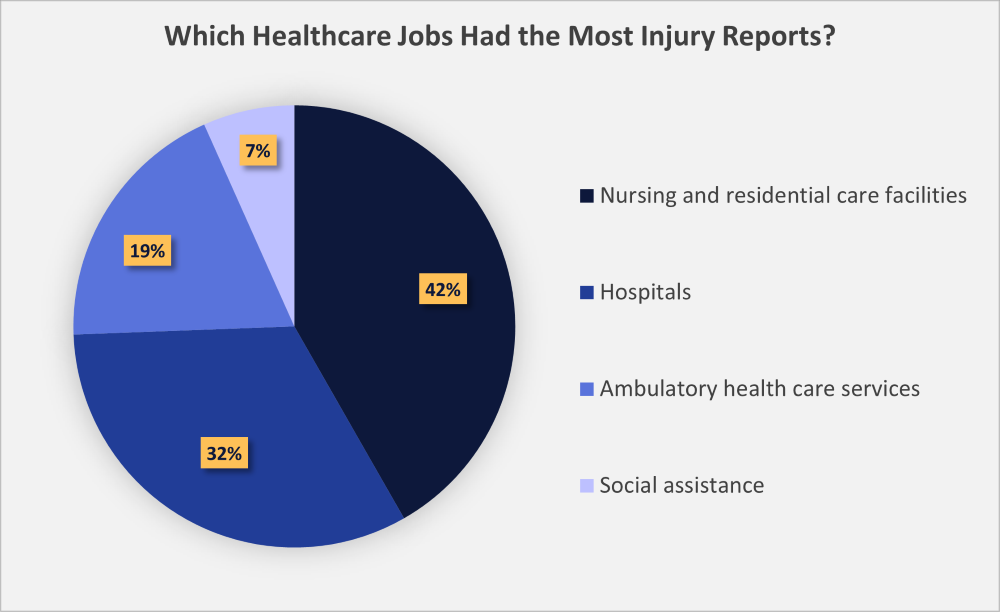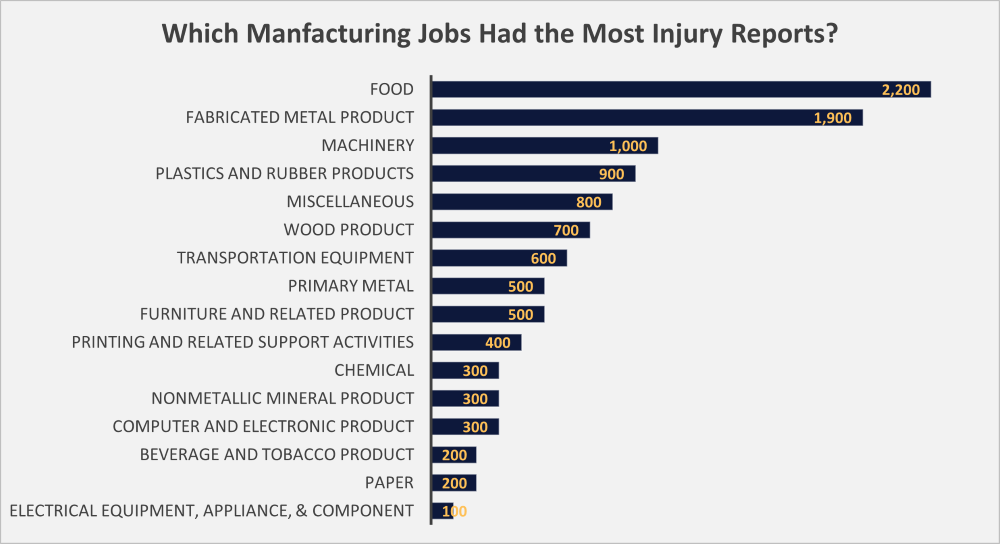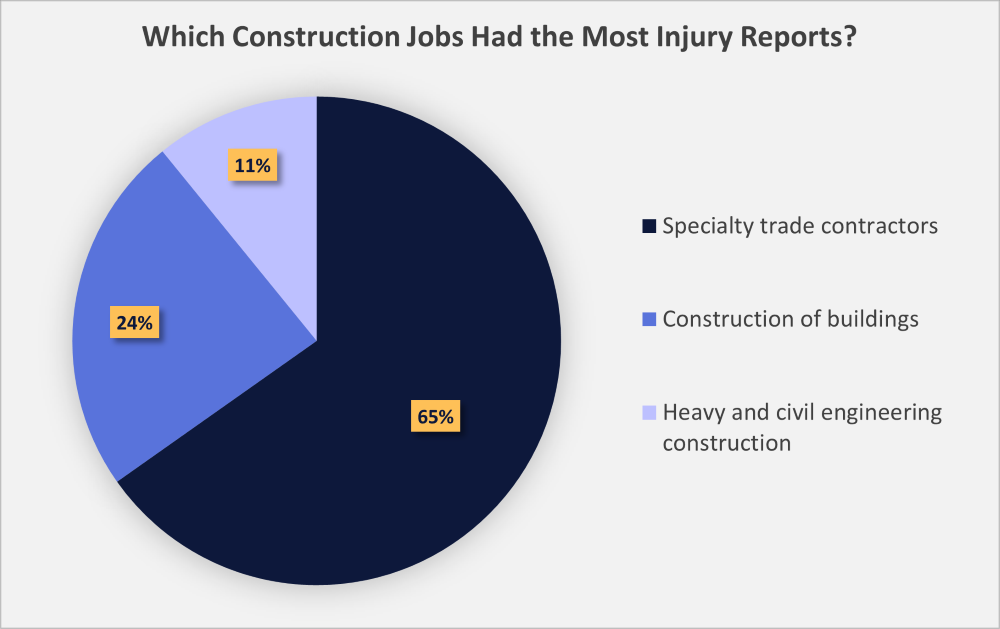Injuries on the job are more common than you may think. Fortunately, Minnesota requires employers to provide their employees with workers’ compensation insurance. Workers’ comp is in place to protect employees who sustain an injury or illness on the job by providing them with compensation to cover their medical bills and lost wages. Because these injuries must be reported in order to receive insurance coverage, the Minnesota Department of Labor and Industry has this data available.
For this study, we analyzed injury data from three industries: healthcare, construction, and manufacturing. We also compared Minnesota to national workplace injury data from the BLS.
According to OSHA, hospitals are actually the most hazardous place to work in America. Nationally, nursing assistants reported the highest number of occupational injuries out of any other occupation in 2020. The Bureau of Labor Statistics reported that health care and social assistance workers had a 40% increase in total injuries and illnesses from 2019 to 2020. Let’s examine how that looked among Minnesota health care workers.

Employees at nursing and residential care facilities reported the most injuries of any health care job, with 42% of the total cases. Hospital employees had the second highest number of reports with 32%.
| HEALTHCARE JOB | TOTAL RECORDABLE CASES |
|---|---|
| Ambulatory health care services | 4,800 |
| Offices of physicians | 2,000 |
| Outpatient care centers | 500 |
| Home health care services | 900 |
| Hospitals | 8,300 |
| General medical and surgical hospitals | 8,300 |
| Nursing and residential care facilities | 10,600 |
| Nursing care facilities (skilled nursing facilities) | 5,800 |
| Residential intellectual and developmental disability, mental health, and substance abuse facilities |
1,900 |
| Continuing care retirement communities and assisted living facilities for the elderly | 2,700 |
| Social assistance | 1,700 |
| Individual and family services | 1,200 |
| Child day care services | 200 |
Note: Numbers are rounded and may not always add up to total.
While the data did not specify all of the exact injuries and illnesses, here is what we do know.
There was only 1 reported fatality from the healthcare industry in 2020. The reason for the fatality was reported as a “transportation incident.” This is defined as any fatal occupational injury involving a roadway, nonroadway, air, water, or rail, including being struck by a vehicle.
Learn more about workers’ compensation for healthcare workers.

Among manufacturing industries, food manufacturing was the one with the most nonfatal injury reports in 2020 with 2,200. This trend was reflected nationally, too; in 2020 the most manufacturing injuries in the U.S. happened in food manufacturing, with 82,000 reports.
Unfortunately not every case in the dataset specified the injury or illness, but here is what was reported.
Learn more about workers’ compensation for industrial workers and factory workers.

The dataset did not contain enough information to specify which injuries and illnesses were sustained in the construction industry.
| CONSTRUCTION JOB | TOTAL RECORDABLE CASES |
|---|---|
| Construction of buildings | 1,100 |
| Nonresidential building construction | 400 |
| Commercial and institutional building construction | 300 |
| Heavy and civil engineering construction | 500 |
| Highway, street, and bridge construction | 200 |
| Specialty trade contractors | 3,000 |
| Foundation, structure, and building exterior contractors | 500 |
| Building equipment contractors (plumbing, electrical, HVAC) | 1,400 |
| Electrical contractors and other wiring installation contractors | 600 |
| Plumbing, heating, and air-conditioning contractors | 700 |
| Building finishing contractors | 700 |
| Other specialty trade contractors | 500 |
Note: Numbers are rounded and may not always add up to total.
Learn more about workers’ compensation for construction workers.
Minnesota was the 10th highest state for total number of workers’ comp cases in 2020.
| RANK | STATE | TOTAL RECORDABLE CASES |
|---|---|---|
| 1 | California | 355,200 |
| 2 | Texas | 178,600 |
| 3 | New York | 129,000 |
| 4 | Pennsylvania | 122,700 |
| 5 | Illinois | 106,900 |
| 6 | Michigan | 88,800 |
| 7 | Ohio | 85,300 |
| 8 | Washington | 78,200 |
| 9 | New Jersey | 75,800 |
| 10 | Minnesota | 66,900 |
| 11 | North Carolina | 64,900 |
| 12 | Indiana | 64,300 |
| 13 | Wisconsin | 59,900 |
| 14 | Arizona | 59,800 |
| 15 | Massachusetts | 58,800 |
| 16 | Tennessee | 57,500 |
| 17 | Missouri | 53,600 |
| 18 | Virginia | 52,600 |
| 19 | Oregon | 43,400 |
| 20 | Maryland | 42,400 |
| 21 | Kentucky | 40,000 |
| 22 | Iowa | 34,000 |
| 23 | Alabama | 33,800 |
| 24 | Connecticut | 33,300 |
| 25 | Nevada | 29,800 |
| 26 | Oklahoma | 29,100 |
| 27 | South Carolina | 29,100 |
| 28 | Kansas | 26,800 |
| 29 | Utah | 26,300 |
| 30 | Arkansas | 25,100 |
| 31 | Louisiana | 22,900 |
| 32 | Nebraska | 19,300 |
| 33 | Maine | 16,700 |
| 34 | New Mexico | 13,200 |
| 35 | West Virginia | 12,900 |
| 36 | Hawaii | 10,900 |
| 37 | Montana | 10,200 |
| 38 | Vermont | 6,900 |
| 39 | Alaska | 6,700 |
| 40 | Delaware | 6,700 |
| 41 | Wyoming | 5,000 |
| 42 | District of Columbia | 4,800 |
Minnesota had 66,900 reported workers’ compensation cases in 2020. Data was not available from Colorado, Florida, Georgia, Idaho, Mississippi, New Hampshire, North Dakota, Rhode Island, or South Dakota.
Although these three industries come with occupational hazards, there are plenty of steps that can be taken to reduce and prevent injuries at work.
If you do get injured at work in Minnesota, make sure to report it as soon as possible to your employer and the Department of Labor. Then contact an experienced workers’ compensation attorney.
"*" indicates required fields